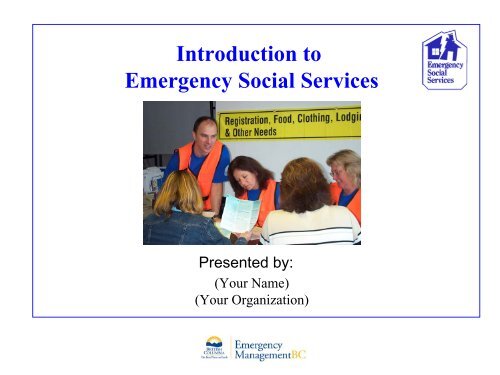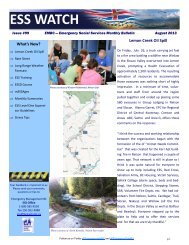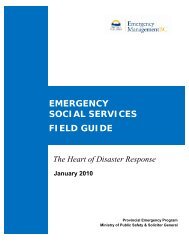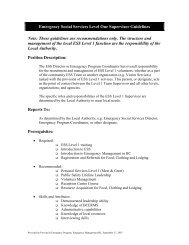Extended Overview of ESS (23 slides) - Emergency Social Services
Extended Overview of ESS (23 slides) - Emergency Social Services
Extended Overview of ESS (23 slides) - Emergency Social Services
You also want an ePaper? Increase the reach of your titles
YUMPU automatically turns print PDFs into web optimized ePapers that Google loves.
<strong>Overview</strong> <strong>of</strong> <strong>ESS</strong>What does <strong>ESS</strong> Do?<strong>ESS</strong> is an integral part <strong>of</strong> <strong>Emergency</strong> Management in BC by:• Helping people to remain independent and selfsufficient• Helping people to meet their basic needs during adisaster• Reuniting families separated by disaster• Providing people with accurate and up-to-dateinformation about the situation at hand• Helping people to re-establish themselves as quickly aspossible after a disaster<strong>Emergency</strong> <strong>Social</strong> <strong>Services</strong>Slide 4
<strong>Overview</strong> <strong>of</strong> <strong>ESS</strong>What services are provided?<strong>ESS</strong> provides primary services such as:• food• lodging• clothing• family reunification (registration & inquiry)<strong>ESS</strong> may also provide specialized services such as:• emotional support• first aid• child care• pet care• public information• radio communications<strong>Emergency</strong> <strong>Social</strong> <strong>Services</strong>Slide 5
<strong>Overview</strong> <strong>of</strong> <strong>ESS</strong>Who provides <strong>ESS</strong>?• <strong>ESS</strong> volunteers and staff– over 5,000 local volunteers and staff across BC– <strong>ESS</strong> Support Organizations– Provincial <strong>Emergency</strong> Program regional and provincial staff• Every local authority in BC should have an <strong>ESS</strong> team• The local <strong>ESS</strong> leader is the <strong>ESS</strong> Director• The <strong>ESS</strong> Director reports to <strong>Emergency</strong> Program Coordinator<strong>Emergency</strong> <strong>Social</strong> <strong>Services</strong>Slide 6
<strong>Overview</strong> <strong>of</strong> <strong>ESS</strong>Local Authority Level<strong>Emergency</strong> <strong>Social</strong> <strong>Services</strong>Slide 7
<strong>Overview</strong> <strong>of</strong> <strong>ESS</strong>Who receives <strong>ESS</strong> ?• Citizens <strong>of</strong> British Columbia who have beendisplaced from their residence by a disaster oremergency• Response workers on assignmentduring a disaster or emergency• Travellers stranded as a result <strong>of</strong> adisaster<strong>Emergency</strong> <strong>Social</strong> <strong>Services</strong>Slide 8
<strong>Overview</strong> <strong>of</strong> <strong>ESS</strong>When is <strong>ESS</strong> provided?• <strong>ESS</strong> may be provided for incidents ranging from a singlefamily house fire to calamities involving mass evacuation• Examples <strong>of</strong>events in BC involving <strong>ESS</strong> include:• floods• urban fires• earthquakes• oil spills• blizzards• severe weather• land<strong>slides</strong> and avalanches• wildland urban interface fires<strong>Emergency</strong> <strong>Social</strong> <strong>Services</strong>Slide 9
<strong>Overview</strong> <strong>of</strong> <strong>ESS</strong>How long is <strong>ESS</strong> provided for?• <strong>ESS</strong> is typically available for 72 hours immediatelyfollowing the start <strong>of</strong> an event• During these first 72 hours, evacuees should immediatelyplan their next steps by contacting:– insurance agents (if relevant)– family and friends– local non-pr<strong>of</strong>it agencies• <strong>ESS</strong> may be extended, in exceptional circumstances, on acase-by-case basis<strong>Emergency</strong> <strong>Social</strong> <strong>Services</strong>Slide 10
<strong>Overview</strong> <strong>of</strong> <strong>ESS</strong>How is <strong>ESS</strong> provided?• <strong>ESS</strong> teams assist evacuees at Reception Centres• <strong>ESS</strong> teams may also provide:– outreach services for shut-ins– Group Lodging (shelter and food) to evacueesduring a major event– on-site services to response workers and others• Level 1 <strong>ESS</strong> volunteers provide on-site services forsmall scale incidents (1-2 residences)<strong>Emergency</strong> <strong>Social</strong> <strong>Services</strong>Slide 11
<strong>Overview</strong> <strong>of</strong> <strong>ESS</strong>What do <strong>ESS</strong> teams do to prepare?• Identify facilities suitable for use as Reception Centresand for Group Lodging.• Recruit and train volunteers• Establish linkages with key local emergency respondersand any disaster related non-government organizations• Reach agreements with local businesses and servicesorganizations<strong>Emergency</strong> <strong>Social</strong> <strong>Services</strong>Slide 12
Roles and ResponsibilitiesWho supports <strong>ESS</strong> teams?• Local authority• PEP Regional Staff• Provincial <strong>Emergency</strong> Program (PEP)• <strong>ESS</strong> Office• <strong>ESS</strong> Support Organizations<strong>Emergency</strong> <strong>Social</strong> <strong>Services</strong>Slide 13
Roles and ResponsibilitiesMunicipal vs. ProvincialThrough the <strong>Emergency</strong> Program Act (1996):• Local Authorities are responsible for emergencyplanning and response, including <strong>ESS</strong>• The Provincial Government is responsible for supportinglocal authorities in this responsibility.<strong>Emergency</strong> <strong>Social</strong> <strong>Services</strong>Slide 14
Roles and ResponsibilitiesWhat is the role <strong>of</strong> Local Authorities?The local authority is responsible for:• Planning and coordination <strong>of</strong> a local <strong>ESS</strong> response• Specifically,– “A local authority must, as part <strong>of</strong> the local emergencyplan prepared by it under section 6 (2) <strong>of</strong> the Act.Section 2 (3) (f) <strong>of</strong> the Local Authority<strong>Emergency</strong> Management Regulation (1995)– “Coordinate the provision <strong>of</strong> food, clothing, shelter,transportation and medical services to victims <strong>of</strong>emergencies and disasters, whether that provision is madefrom within or outside <strong>of</strong> the local authority.”<strong>Emergency</strong> <strong>Social</strong> <strong>Services</strong>Slide 15
Roles and ResponsibilitiesWhat is the role <strong>of</strong> PEP?The Provincial <strong>Emergency</strong> Program (PEP) isresponsible for:• Leadership and overall coordination <strong>of</strong> BC’s emergencymanagement system• Providing a task number and expenditures authority in anemergency (1-800-663-3456)• Provides public information about on-going disasters,emergency preparedness and preventive measures• Providing WCB and liability coverage for <strong>ESS</strong> volunteers<strong>Emergency</strong> <strong>Social</strong> <strong>Services</strong>Slide 16
Roles and ResponsibilitiesWhat is the role <strong>of</strong> the <strong>ESS</strong> Office?The Provincial <strong>Emergency</strong> Program’s <strong>ESS</strong> Office provides provincial levelsupport for local authorities who are responsible for planning, and respondingto, emergencies and disaster where short-term emergency social services arerequired.The <strong>ESS</strong> Office works alongside other provincial ministries and nongovernmentorganizations, to coordinate provincial level resources in support<strong>of</strong> the delivery <strong>of</strong> <strong>ESS</strong> across British Columbia by local authorities.PEP Headquarters and the <strong>ESS</strong> Office support local authorities by:• Funding the <strong>ESS</strong> training program;• Developing provincial policies and procedures;…continued on next slide<strong>Emergency</strong> <strong>Social</strong> <strong>Services</strong>Slide 17
Roles and ResponsibilitiesWhat is the role <strong>of</strong> the <strong>ESS</strong> Office?Continued:• Providing a framework, including guidelines, standards and bestpractices, for use by local authorities and the <strong>ESS</strong> training program;• Develop and maintain relationships with <strong>ESS</strong> Support Organizations;• The processing <strong>of</strong> invoices for lodging, food, clothing and othernecessary expenses administered by community <strong>ESS</strong> teams during anemergency;• Providing provincial support during a major disaster; and• Negotiating federal and provincial <strong>ESS</strong> mutual aid in the event <strong>of</strong> acatastrophic disaster.<strong>Emergency</strong> <strong>Social</strong> <strong>Services</strong>Slide 18
Roles and ResponsibilitiesWhat is the role <strong>of</strong> Support Organizations?The <strong>ESS</strong> Office can also arrange additional volunteer support andservices from the following <strong>ESS</strong> Support Organizations:•BC Housing - warehousing and distribution <strong>of</strong>cots and blankets for Group Lodging•Buddhist Compassion Relief Tzu ChiFoundation Canada - mass feeding operations•Canadian Red Cross - Family Reunification<strong>Services</strong>, operation <strong>of</strong> the Central Registration &Inquiry Bureau (CRIB)•<strong>ESS</strong> Association - community volunteersupport•Justice Institute <strong>of</strong> BC – <strong>ESS</strong> volunteertraining courses•The Salvation Army - emotionalsupport and meet & greet services•Canadian Disaster Child Care – careand assistance <strong>of</strong> children affected by disaster<strong>Emergency</strong> <strong>Social</strong> <strong>Services</strong>Slide 19
Key <strong>ESS</strong> FactsHistorical ResponsesYearNumber <strong>of</strong>Persons Assisted2007 4,1002006 6,8582005 5,0632004 2,5632003 40,0352002 3,6182001 2,4342000 1,582<strong>Emergency</strong> <strong>Social</strong> <strong>Services</strong>Slide 20
Key <strong>ESS</strong> Facts<strong>ESS</strong> Responses in BC 1994 - 2007Total Persons Assisted: 93,874– forest fire related 53,810– other (e.g. house fires, apartment fires,power outage, land<strong>slides</strong>,gas leaks, blizzards, etc) 40,064Total number <strong>of</strong> incidents involving <strong>ESS</strong>: 3,833– forest fire related 43– other (e.g. house fires, apartment fires, 3,790power outages, floods, land<strong>slides</strong>gas leaks, blizzards, etc)<strong>Emergency</strong> <strong>Social</strong> <strong>Services</strong>Slide 21
ConclusionThe success <strong>of</strong> <strong>ESS</strong> depends on the ongoing commitment<strong>of</strong> volunteers and other key stakeholders, and on thesupport <strong>of</strong> local, regional and provincial governments.<strong>Emergency</strong> <strong>Social</strong> <strong>Services</strong>Slide 22
<strong>Emergency</strong> <strong>Social</strong> <strong>Services</strong>Slide <strong>23</strong>









